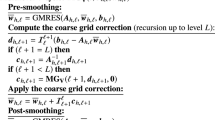Abstract
We present optimal preconditioners for a recently introduced hybridized discontinuous Galerkin finite element discretization of the Stokes equations. Typical of hybridized discontinuous Galerkin methods, the method has degrees-of-freedom that can be eliminated locally (cell-wise), thereby significantly reducing the size of the global problem. Although the linear system becomes more complex to analyze after static condensation of these element degrees-of-freedom, the pressure Schur complement of the original and reduced problem are the same. Using this fact, we prove spectral equivalence of this Schur complement to two simple matrices, which is then used to formulate optimal preconditioners for the statically condensed problem. Numerical simulations in two and three spatial dimensions demonstrate the good performance of the proposed preconditioners.
Similar content being viewed by others
References
Balay, S., Abhyankar, S., Adams, M.F., Brown, J., Brune, P., Buschelman, K., Dalcin, L., Eijkhout, V., Gropp, W.D., Kaushik, D., Knepley, M.G., McInnes, L.C., Rupp, K., Smith, B.F., Zampini, S., Zhang, H., Zhang, H.: PETSc users manual. Technical Report ANL-95/11 - Revision 3.7, Argonne National Laboratory. http://www.mcs.anl.gov/petsc (2016)
Balay, S., Abhyankar, S., Adams, M.F., Brown, J., Brune, P., Buschelman, K., Dalcin, L., Eijkhout, V., Gropp, W.D., Kaushik, D., Knepley, M.G., McInnes, L.C., Rupp, K., Smith, B.F., Zampini, S., Zhang, H., Zhang, H.: PETSc Web page. http://www.mcs.anl.gov/petsc (2016)
Boffi, D., Brezzi, F., Fortin, M.: Mixed Finite Element Methods and Applications. Springer Series in Computational Mathematics, vol. 44. Springer, Berlin (2013)
Brenner, S.C., Scott, L.: The Mathematical Theory of Finite Element Methods, 3rd edn. Springer, Berlin (2008)
Cesmelioglu, A., Cockburn, B., Nguyen, N.C., Peraire, J.: Analysis of HDG methods for Oseen equations. J. Sci. Comput. 55, 392–431 (2013). https://doi.org/10.1007/s10915-012-9639-y
Cesmelioglu, A., Cockburn, B., Qiu, W.: Analysis of a hybridizable discontinuous Galerkin method for the steady-state incompressible Navier–Stokes equations. Math. Comput. 86, 1643–1670 (2017). https://doi.org/10.1090/mcom/3195
Cockburn, B., Gopalakrishnan, J.: The derivation of hybridizable discontinuous Galerkin methods for Stokes flow. SIAM J. Numer. Anal. 47(2), 1092–1125 (2009). https://doi.org/10.1137/080726653
Cockburn, B., Sayas, F.J.: Divergence-conforming HDG methods for Stokes flows. Math. Comput. 83, 1571–1598 (2014). https://doi.org/10.1090/S0025-5718-2014-02802-0
Cockburn, B., Gopalakrishnan, J., Nguyen, N.C., Peraire, J., Sayas, F.J.: Analysis of HDG methods for Stokes flow. Math. Comput. 80(274), 723–760 (2011). https://doi.org/10.1090/S0025-5718-2010-02410-X
Dobrev, V.A., Kolev, T.V., et al.: MFEM: Modular finite element methods. http://mfem.org (2018)
Hansbo, P., Larson, M.G.: Discontinuous Galerkin methods for incompressible and nearly incompressible elasticity by Nitsche’s method. Comput. Methods Appl. Mech. Eng. 191, 1895–1908 (2002). https://doi.org/10.1016/S0045-7825(01)00358-9
Henson, V.E., Yang, U.M.: BoomerAMG: a parallel algebraic multigrid solver and preconditioner. Appl. Numer. Math. 41(1), 155–177 (2002). https://doi.org/10.1016/S0168-9274(01)00115-5
Howell, J.S., Walkington, N.J.: Inf-sup conditions for twofold saddle point problems. Numer. Math. 118, 663–693 (2011). https://doi.org/10.1007/s00211-011-0372-5
John, V., Linke, A., Merdon, C., Neilan, M., Rebholz, L.G.: On the divergence constraint in mixed finite element methods for incompressible flows. SIAM Rev. 59(3), 492–544 (2017). https://doi.org/10.1137/15M1047696
Labeur, R.J., Wells, G.N.: Energy stable and momentum conserving hybrid finite element method for the incompressible Navier–Stokes equations. SIAM J. Sci. Comput. 34(2), A889–A913 (2012). https://doi.org/10.1137/100818583
Lee, C.H., Vassilevski, P.S.: Parallel solver for \(H\)(div) problems using hybridization and AMG. In: Domain Decomposition Methods in Science and Engineering XXIII, pp. 69–80. Springer (2017). https://doi.org/10.1007/978-3-319-52389-7_6
Lehrenfeld, C., Schöberl, J.: High order exactly divergence-free hybrid discontinuous Galerkin methods for unsteady incompressible flows. Comput. Methods Appl. Mech. Eng. 307, 339–361 (2016). https://doi.org/10.1016/j.cma.2016.04.025
Nguyen, N.C., Peraire, J., Cockburn, B.: A hybridizable discontinuous galerkin method for stokes flow. Comput. Methods Appl. Mech. Eng. 199(9–12), 582–597 (2010). https://doi.org/10.1016/j.cma.2009.10.007
Nguyen, N.C., Peraire, J., Cockburn, B.: An implicit high-order hybridizable discontinuous Galerkin method for the incompressible Navier–Stokes equations. J. Comput. Phys. 230(4), 1147–1170 (2011). https://doi.org/10.1016/j.jcp.2010.10.032
Pestana, J., Wathen, A.J.: Natural preconditioning and iterative methods for saddle point systems. SIAM Rev. 57(1), 71–91 (2015). https://doi.org/10.1137/130934921
Qiu, W., Shi, K.: A superconvergent HDG method for the incompressible Navier–Stokes equations on general polyhedral meshes. IMA J. Numer. Anal. 36(4), 1943–1967 (2016). https://doi.org/10.1093/imanum/drv067
Rhebergen, S., Cockburn, B.: A space-time hybridizable discontinuous galerkin method for incompressible flows on deforming domains. J. Comput. Phys. 231(11), 4185–4204 (2012). https://doi.org/10.1016/j.jcp.2012.02.011
Rhebergen, S., Wells, G.N.: Analysis of a hybridized/interface stabilized finite element method for the Stokes equations. SIAM J. Numer. Anal. 55(4), 1982–2003 (2017). https://doi.org/10.1137/16M1083839
Rhebergen, S., Wells, G.N.: A hybridizable discontinuous Galerkin method for the Navier-Stokes equations with pointwise divergence-free velocity field. J. Sci. Comput. (2018). https://doi.org/10.1007/s10915-018-0671-4
Wells, G.N.: Analysis of an interface stabilized finite element method: the advection-diffusion-reaction equation. SIAM J. Numer. Anal. 49(1), 87–109 (2011). https://doi.org/10.1137/090775464
Author information
Authors and Affiliations
Corresponding author
Additional information
SR gratefully acknowledges support from the Natural Sciences and Engineering Research Council of Canada through the Discovery Grant program (RGPIN-05606-2015) and the Discovery Accelerator Supplement (RGPAS-478018-2015).
Appendix A: Auxiliary Results
Appendix A: Auxiliary Results
We provide here some auxiliary results used in analyzing the preconditioners.
Defining \(a_h^{uu}(u_h, v_h) := a_h((u_h, 0), (v_h, 0))\), since \({|\!|\!| v_h |\!|\!|}_{DG} = {|\!|\!| (v_h, 0) |\!|\!|}_v\), a consequence of Eq. (12) is:
Applying [11, Proposition 10] to a single cell K, the following inf-sup condition holds:
where \(\beta _{DG}^K > 0\) is a constant independent of h, \(V_h(K) := \mathinner { \left[ P_k(K)\right] } ^d\) and \({|\!|\!| v_h |\!|\!|}_{DG(K)}^2 := \parallel \nabla v_h \parallel ^2_{K} + \alpha h_K^{-1} \parallel v_h \parallel ^2_{\partial K}\). It follows that
where \(\beta _{DG} := \min _{K \in \mathcal {T}} \beta _{DG}^K\). Since \({|\!|\!| v_h |\!|\!|}_{DG} = {|\!|\!| (v_h, 0) |\!|\!|}_v\), it is easy to see from Eq. (26) that
where \(\bar{\beta }_{DG} > 0\) is a constant independent of h.
Rights and permissions
About this article
Cite this article
Rhebergen, S., Wells, G.N. Preconditioning of a Hybridized Discontinuous Galerkin Finite Element Method for the Stokes Equations. J Sci Comput 77, 1936–1952 (2018). https://doi.org/10.1007/s10915-018-0760-4
Received:
Revised:
Accepted:
Published:
Issue Date:
DOI: https://doi.org/10.1007/s10915-018-0760-4




